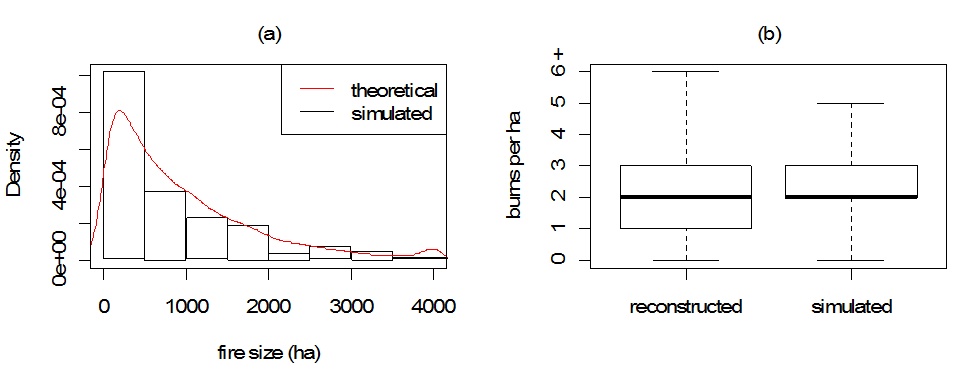Quite a while ago I’ve been blogging about a new simulation experiment that we’ve been working on using iLand. Well, the good news is that the corresponding paper was now published in Ecological Applications. In this study we’ve used iLand to quantify the resilience (of structure, composition, and functioning) to disturbance, and tested how live tree legacies (i.e., remnant live trees that are carried over into the post disturbance landscape) modulate resilience.
In my post today I, however, want to focus on the model development that was necessary to implement this study, in particular the development of a wildfire module for iLand (as this is something that is relegated to the Online Supplement of the paper, I figured I’d highlight it here). So besides the wind module, the second fully published and tested disturbance module that is now available for iLand is on fire (pun intended). Our main development goals were (i) for the module to be fully integrated into the iLand environment in order to simulate dynamic vegetation – disturbance – vegetation feedbacks, (ii) to use a process-based framework addressing the principal processes ignition, spread, vegetation impact, and extinction explicitly.
In contrast to the wind module, where we’ve been putting quite some time and energy into developing a new and novel approach to modeling this disturbance agent, we’ve based the iLand wildfire module on previous experiences in wildfire modeling, in particular on the approaches of LADS, FireBGC v2.0, and LandClim.
If this sounds not that exciting for you I say: not so fast! The added value here comes from a well thought out combination of the strengths of these different approaches (LADS: grounded in empirical data and developed for large-scale applications, FireBGC: high process detail and integration with biogeochemical cycling, LandClim: parsimony and integration with vegetation dynamics at the landscape), and their incorporation in iLand. It’s particularly the high resolution of iLand (individual tree level) that makes addressing questions like the current one feasible. And besides: Yes, we do have fun in developing models, but not in reinventing the wheel. And since wildfire is arguably the best researched (and most frequently modeled) disturbance agent in temperate and boreal forests we chose this route for this particular agent.
After looking at a number of fire simulators in detail and developing the iLand fire module we were of course curious to see how it all works out. And since a thorough model evaluation is a prerequisite for any simulation study we engaged into an in depth parameterization and evaluation exercise with iLand, using independent empirical data from the HJ Andrews Experimental Forest (HJA). We used the extinction probability of the cellular automaton-based fire spread algorithm to parameterize fire complexity. Furthermore, we re-evaluated the crown kill function developed by Schumacher et al. (2006) for Rocky Mountains ecosystems and adapted it for our purposes in the Western Cascades of Oregon. With the model thus set up we tested, whether the fire regime of the last 500 years (reconstructed by means of dendroecology) could be realistically reproduced by the model. In these tests, the simulated mean fire (916 ha) corresponded well to the reconstructed mean fire size for the landscape (965 ha). The dynamically simulated mean fire return interval (MFRI) of 218 years for the entire HJA landscape was slightly lower than the reconstructed value (262 years). However, the expected pattern of decreasing MFRI with increasing elevation was reproduced by the dynamic fire simulations with iLand (see Figure, and Appendix B here for details).

Figure: (a) Simulated versus expected fire sizes. (b) Frequency of fires per hectare for the 6364 ha HJA landscape from fire history reconstructions and iLand simulations. Simulation results are the derived from ten replicates of a 500 year simulation series.
Overall we’re quite happy with how things turned out, and with having another disturbance module available in iLand. As always we’ll shortly roll out a new version of the model (executable + code + online documentation wiki) including all these new developments. But the show must go on of course… right now we’re back to where I personally started with my PhD, as we’re currently working on integrating also a bark beetle module into iLand. Stay tuned!